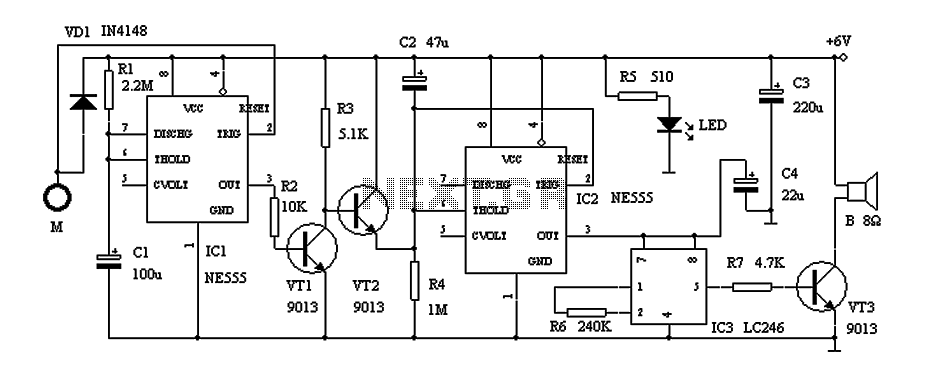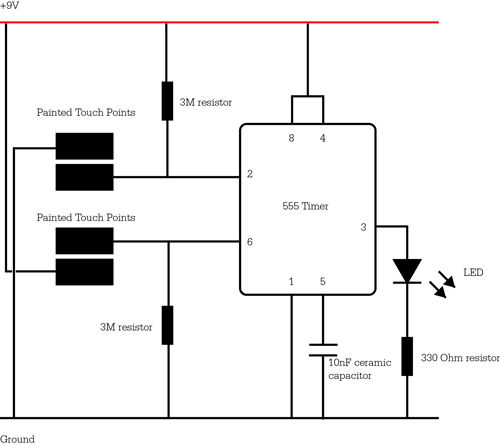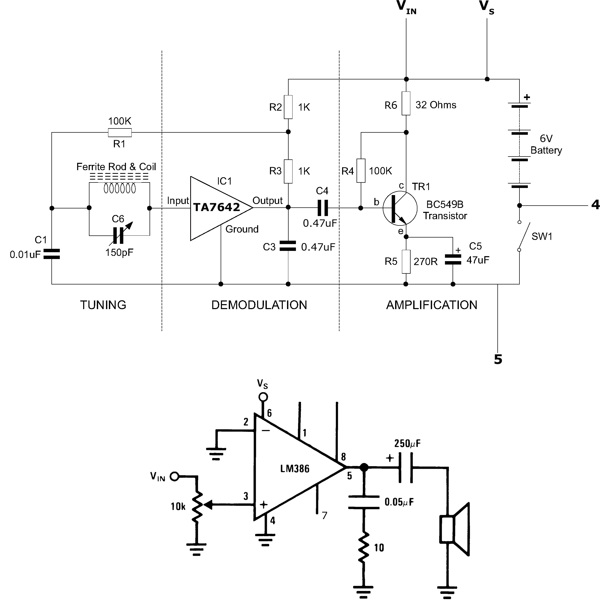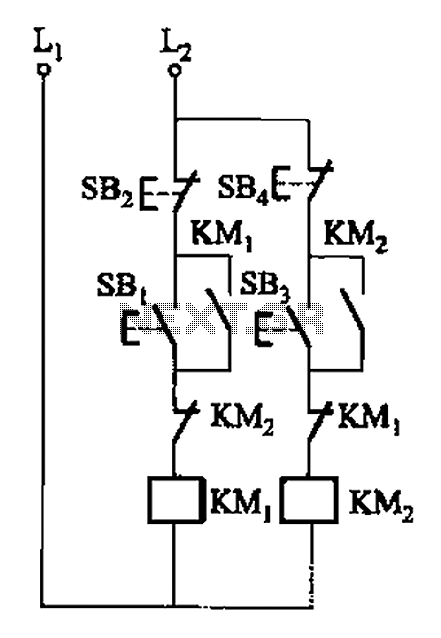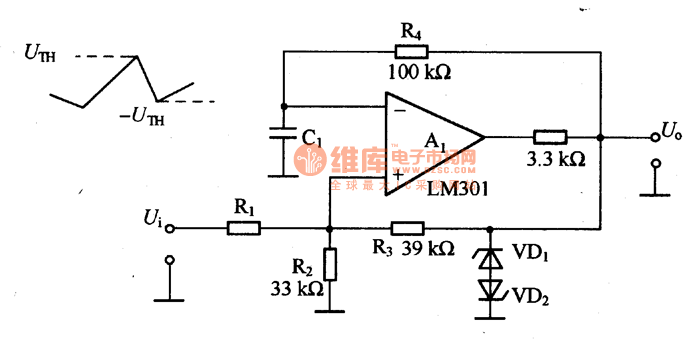
AM circuit by MC1496
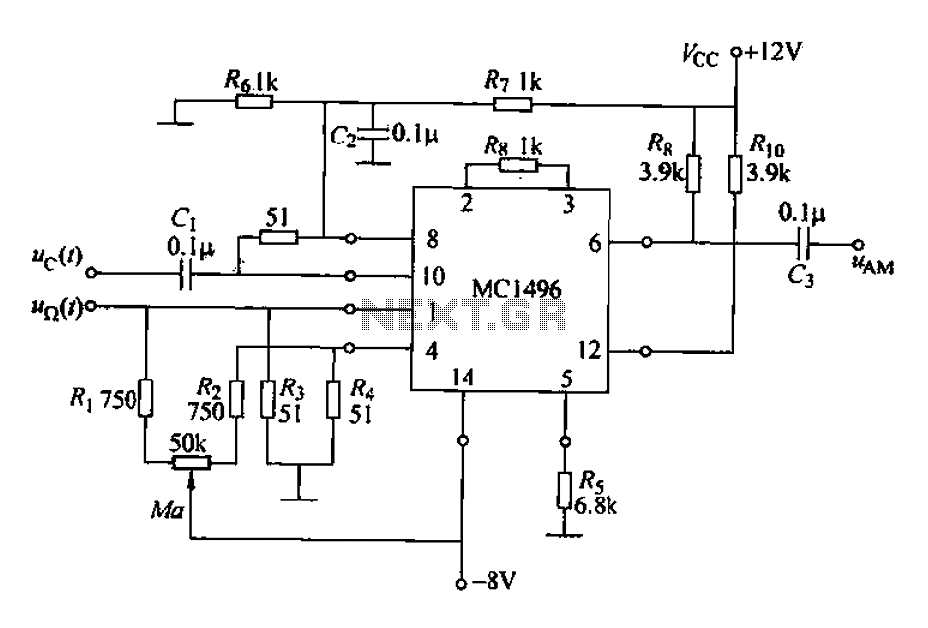
The configuration of the AM MC1496 analog multiplier integrated circuit is illustrated in Figure 21-39. It features a two-input channel where the DC levels of the pins are set at 6V, allowing it to function as a carrier channel for two input channels. The Y input has an external connection that maintains a zero circuit. By adjusting a potentiometer, a potential of 50kΩ can be achieved, which is higher than the zero level. The modulation signal u(t) is superimposed with the DC input voltage UY of the Y channel. The potentiometer can be adjusted to modify the modulation index Ma. The output terminal connects to a bandpass filter that is tuned to the carrier frequency. A negative feedback resistor connects to the Y channel. The circuit depicted in Figure 21-39 represents a double-sideband amplitude modulation circuit. The potentiometer adjustment aims to ensure that the DC potential difference at the Y channel remains at zero, allowing only the AC modulation signal to be present at the Y-channel input. To minimize the current flowing through the potentiometer and facilitate accurate zeroing, two 750Ω resistors can be added, with each resistor being 10kΩ.
The AM MC1496 analog multiplier integrated circuit is designed for applications involving amplitude modulation, particularly in communication systems where signal integrity is crucial. The circuit operates by utilizing two input channels, allowing for the modulation of a carrier signal. The configuration ensures that the DC bias level is correctly set to 6V, which is vital for the proper functioning of the multiplier.
The Y input is particularly important as it allows for the superimposition of an AC modulation signal onto the DC input voltage. By employing a potentiometer, users can finely tune the modulation index, which directly affects the depth of modulation and, consequently, the quality of the transmitted signal. This tuning capability is essential in optimizing the performance of the modulation process.
The output of the circuit is connected to a bandpass filter, which is crucial for isolating the desired frequency components of the modulated signal while attenuating unwanted frequencies. The tuning of this filter is aligned with the carrier frequency, ensuring that the output signal maintains its integrity and is suitable for further processing or transmission.
Negative feedback is implemented through a resistor connected to the Y channel, which stabilizes the circuit and enhances linearity. This feedback mechanism is important for reducing distortion and improving the overall performance of the modulation process.
To achieve precise control over the input signal levels, the potentiometer is adjusted to maintain a zero DC potential difference at the Y channel. This adjustment allows only the AC modulation signal to pass through, ensuring that the output is a clean representation of the desired modulated signal.
In scenarios where the potentiometer's current needs to be minimized for accurate adjustments, the addition of two 750Ω resistors is recommended. This configuration helps in reducing the load on the potentiometer, facilitating easier and more accurate tuning to achieve the desired modulation characteristics.
Overall, the AM MC1496 integrated circuit configuration as described offers a robust solution for amplitude modulation applications, providing flexibility in tuning and ensuring high-quality signal transmission.AM MC1496 analog multiplier integrated circuit configuration shown in Figure 21-39. Channel two-input, ? pin DC bits are 6V, can be used as a carrier channel two input channels } Y input O, feet between external have zero circuit, by adjusting potentiometer allows 50kn potential than O foot foot high Uy, the modulation signal u ( ) is superimposed with the DC input voltage UY Y channel. Adjust the potentiometer to change the modulation index Ma. Output terminal, feet to bandpass filter tuned to the carrier frequency., feet between the outer negative feedback resistor connected to the Y channel.
The circuit shown indiscriminately 21-39 double-sideband amplitude modulation circuit can be composed, adjust the potentiometer is intended to make the Y channel O, feet between the DC potential difference is zero, the Y-channel input signal only the AC modulation signal. In order to reduce the current flowing through the potentiometer, accurate and easy to zero, can increase two 75051 resistor, such as increased each lOkn.
The AM MC1496 analog multiplier integrated circuit is designed for applications involving amplitude modulation, particularly in communication systems where signal integrity is crucial. The circuit operates by utilizing two input channels, allowing for the modulation of a carrier signal. The configuration ensures that the DC bias level is correctly set to 6V, which is vital for the proper functioning of the multiplier.
The Y input is particularly important as it allows for the superimposition of an AC modulation signal onto the DC input voltage. By employing a potentiometer, users can finely tune the modulation index, which directly affects the depth of modulation and, consequently, the quality of the transmitted signal. This tuning capability is essential in optimizing the performance of the modulation process.
The output of the circuit is connected to a bandpass filter, which is crucial for isolating the desired frequency components of the modulated signal while attenuating unwanted frequencies. The tuning of this filter is aligned with the carrier frequency, ensuring that the output signal maintains its integrity and is suitable for further processing or transmission.
Negative feedback is implemented through a resistor connected to the Y channel, which stabilizes the circuit and enhances linearity. This feedback mechanism is important for reducing distortion and improving the overall performance of the modulation process.
To achieve precise control over the input signal levels, the potentiometer is adjusted to maintain a zero DC potential difference at the Y channel. This adjustment allows only the AC modulation signal to pass through, ensuring that the output is a clean representation of the desired modulated signal.
In scenarios where the potentiometer's current needs to be minimized for accurate adjustments, the addition of two 750Ω resistors is recommended. This configuration helps in reducing the load on the potentiometer, facilitating easier and more accurate tuning to achieve the desired modulation characteristics.
Overall, the AM MC1496 integrated circuit configuration as described offers a robust solution for amplitude modulation applications, providing flexibility in tuning and ensuring high-quality signal transmission.AM MC1496 analog multiplier integrated circuit configuration shown in Figure 21-39. Channel two-input, ? pin DC bits are 6V, can be used as a carrier channel two input channels } Y input O, feet between external have zero circuit, by adjusting potentiometer allows 50kn potential than O foot foot high Uy, the modulation signal u ( ) is superimposed with the DC input voltage UY Y channel. Adjust the potentiometer to change the modulation index Ma. Output terminal, feet to bandpass filter tuned to the carrier frequency., feet between the outer negative feedback resistor connected to the Y channel.
The circuit shown indiscriminately 21-39 double-sideband amplitude modulation circuit can be composed, adjust the potentiometer is intended to make the Y channel O, feet between the DC potential difference is zero, the Y-channel input signal only the AC modulation signal. In order to reduce the current flowing through the potentiometer, accurate and easy to zero, can increase two 75051 resistor, such as increased each lOkn.
